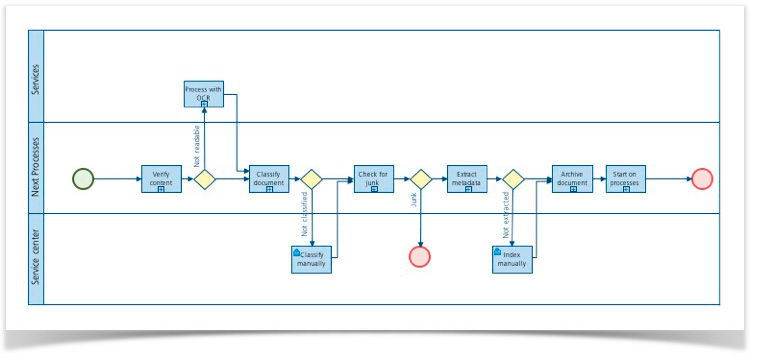Blog
BPMN – no silver bullet, still has a lot to offer
We have learned — the hard way — that BPMN is no silver bullet. Still we embrace Business Process Model and Notation, and for good reasons.
If you read my post 'BPMN is great, but no silver bullet', you'll know that we had huge expectations to BPMN.
BPMN comes with the promise of unlimited flexibility, and the ease of point and click — drag and drop. Now anyone can do their own business processes over night — right?
Wrong. We were wrong. That is simply not the promise of BPMN.
As a manager you don't refactor your processes overnight, and expect the organization to behave differently in the morning. Refactoring an organization takes planning. Analysis and planning. Nothing new here.
What's in it then?
In my view, the primary benefits of BPMN – from a business perspective – fall into 4 categories:
- Flexibility
- Documentation
- Audit and review
- Common language
Flexibility
Even if end users are not 'point-and-click' designing their own business processes (as some had hoped for), defining core business processes in BPMN does encourage a higher level of flexibility in the solution. We see much more business relevant parameters externalized that end users may adjust later. And many more processes where decisions rely on data available in other business systems. Absolutely no magic in using web services, and external data, but BPMN simply encourage you to do so.

Documentation
Some organizations do it – document their business processes and systems to the most minute detail. In my experience it's primarily companies in highly regulated industries such as pharmaceuticals, who have successfully made this their second nature. The rest of us tends to cut corners. Not because we are evil, or lazy. Simply because it takes time, and we have better things to do – we believe.

When you use BPMN to implement your business processes, you can hardly avoid making this documentation. It's the documentation that actually runs your business. Of course you can make bad BPMN, and thereby bad documentation, but you can't avoid making documentation. And with the right methodology, you actually make great documentation, and documentation that is always up to date. As said before – it's the documentation that runs your business.
Audit and review
Nothing prevents you from building detailed logging into your business systems, if you develop them yourselves. Most organizations just don't.
Nothing prevents you from manually maintaining detailed logs of every activity performed using paper, email, or business systems. Most organizations just don't.
With business processes defined in BPMN, and run in a BPMN compliant process engine, you simply can't avoid it. Every single action is automatically logged: who, what, and when.
While this is a nonnegotiable requirement in pharmacauticals, it for sure is a valuable benefit in any industry.
Common language
Maybe the most valuable contribution of BPMN, is the fact that it brings to the table a common language for all the people involved in optimizing and automating business processes.
Office workers, managers, and business executives all possess knowledge about, have requirements to, and live with the consequences of implemented business processes. Business process specialists and software engineers have experience in, and master the tools to, implementing new business processes in software. But getting all these people on the same page has proven difficult in the past.
The illustration with the swing is a classic, but still very true. Without dialog and a common language to facilitate this dialog, refactoring business processes is highly complicated, and very likely to go wrong.
An executable BPMN is a highly complex construction, with a ton of highly technical details, that are both irrelevant and completely incomprehensible to most of us. Still the backbone of the BPMN is the same diagram, you'd use to discuss the future process with your line of business manager, and with the front office clerk.
Basic BPMN diagrams can easily be drafted in the business using a tool like Visio. Such a diagram will not reveal the technical implementation, including integration and error handling, but still it makes the future dialog much more qualified.
Love makes you blind
We hoped that BPMN would take all the complexity out of implementing new, and modifying existing, business processes. Today, I wonder how we could be so naive. How could we overnight ditch 25 years of hard earned experience, and truly believe that we had found the world's first silver bullet? I don't have the answer, except the fact that 'love makes you blind', and the concept of 'Everyone point-and-click' designing their own business processes' has a whole lot of sex appeal.
Now we know better. The love for BPMN is not gone, just calmed by reason. From time to time we meet up with managers who also hope to point-and-click their way into full blown, coherent, integrated, professionally performing, well documented, audit logging, and error free business processes. We try – as careful as possible – to convey our findings: 'it may be what you want, but it's not what you need'. As you can imagine this is not always an easy dialog - but we take the beatings it takes.
Recap
Let me briefly recap this blog entry.
- We have done business process optimization for 30 years.
- We fell head over heals in love with BPMN
- We believed BPMN to be the worlds first sliver bullet
- We now know better
- We still love BPMN for what it is
Next post
In my next post I will share with you how exactly BPMN has influenced the architecture of Next.
Stay tuned.









